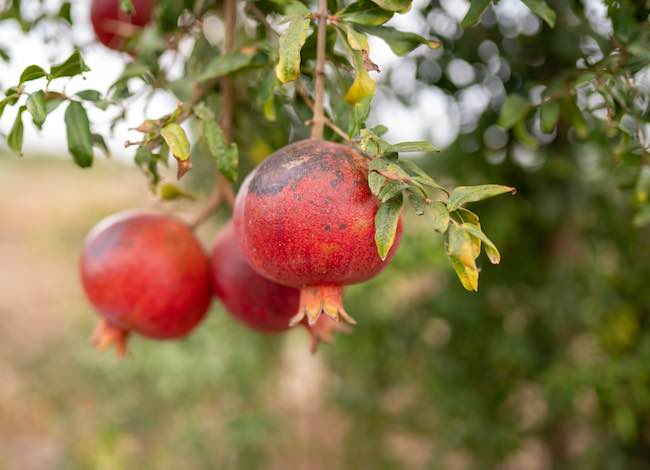How to Prune a Pomegranate Tree

Pruning a pomegranate tree is not as tricky as you might believe. Get your hands dirty and you will reap luscious fruits. The guidance here will teach you how to prune correctly to ensure a superb outcome.
Getting to Know the Pomegranate Tree
The pomegranate tree – Punica granatum – has a long history as a beloved fruiting plant, celebrated globally for its sweet-tart, nutrient-dense pomegranate arils encased in thick crimson skins. Indigenous from Iran to Northern India, these handsome trees thrive in hot, dry climates but can grow in more temperate areas with the right care.
Mature trees reach up to 20 feet tall at times, showing off elegant, narrow green leaves that provide dappled shade. Brilliant coral-red blooms develop along the branches, later producing the iconic spherical fruits.
Decoding Pomegranate Tree Growth Patterns
Unlike more uniformly-shaped fruit trees, pomegranates have a distinct growth habit evident in both immature and mature specimens. Instead of a single trunk, younger pomegranates form a clustered clump of vertical stems originating from the base, eventually melding into one cohesive multi-trunk shrub. This gives mature trees an overarching umbrella canopy shape as the willowy branches arch outward before gravity weighs them down.
Trees grown as solitary trunks will also generate numerous side shoots. During the first decade, juvenile pomegranates focus energy on enthusiastic expansion of new stems and leaves along with showy bloom displays. After formative structural growth concludes, trees transition to emphasising reliable fruit production rather than rampant vertical gains. Maximum final height and width vary significantly based on cultivar genetics, climate, and provided care over the lifetime. Fruit yield and quality peak once full maturity is reached then slowly decline in old age as resources shrink.
Picking the Prime Pruning Time
Available online resources show that optimal timing is imperative when grooming pomegranate trees. Late winter, at the onset of renewed vegetative activity, is widely recommended as the most advantageous window for pruning. Early spring can serve as a secondary target timeline as well. Trimming trees during dormancy avoids interfering with critical developmental phases later on. Pruning at this transitional juncture removes pesky damaged branches from past weather extremes that may invite disease while simultaneously guiding the tree’s forthcoming growth trajectory.
It permits fair weather recovery before the demanding growing season taxed by leaf, flower, and fruit production. Sap flow remains minimal, lowering disease transmission risks compared to pruning during active growth cycles. Warm conditions following winter dormancy also enable optimal wound closure processes for reduced infection chances.
Why Proper Pruning Is Paramount
Appropriate pruning cuts provide benefits extending beyond basic tree upkeep. Aside from aesthetics, pruning stimulates improved tree vigour, longevity, strength, and productivity. Pruned branches allow increased light and air movement through the canopy which keeps inner leaves actively photosynthesizing to manufacture essential tree food resources. Enhanced airflow also quickly dries damp foliage to discourage fungal and bacterial diseases.
Eliminating overly congested growth curbs pest hiding spots too. Pruning reduces weight loads that could otherwise cause branch failures during inclement weather. Removing sick or damaged limbs through pruning bolsters general tree health by preventing the spread of pathogens to healthy tissue. When done correctly, pruning reinvigorates fruiting wood, increasing both quality and quantities. Lastly, commonsense pruning controls ultimate size for easier maintenance and harvest access.
Compiling Essential Pruning Tools
Before heading out to prune, ensure you have gathered all necessary supplies for the task at hand. The smaller the branch is, the handier a pair of gardening pruners becomes. Standard bypass pruners effortlessly slice stems under half an inch thick. Sturdy loppers extend cutting capacity up to two-inch diameter branches. Better leverage and strength generates enough force for a clean cut rather than crushing damage.
Pruning saws efficiently tackle old wood exceeding lopper range – aim for compact razortooth models over wobbly bow saws for best control. Lastly, supplement with handheld snips as needed for detail tidying cuts in tight spaces. Whatever collection of tools picked, honing cutters to a razor glint guards healthy living sapwood from domination by opportunistic microbes. Disinfect all equipment between trees using bleach, alcohol, or other antimicrobial rinses to halt transmission of any unwanted pests from thirsty blades.
Sizing Up Trees Before Snipping Starts
Before breaking out the tools, carefully go over the whole tree looking for any indications of disease or pest damage on the wood or leaves. If any compromised areas are spotted, address them straight away. Eliminating infected branches not only hinders further contamination but also bolsters the overall vigor of the tree.
Selecting Branches for Removal
Selecting appropriate branches to remove is equally as vital as knowing proper pruning methods. Dead or dying branches make prime removal candidates. You can identify dead wood by the lack of foliage or soft, easily damaged wood. Branches that rub together or grow inward toward the centre should also be pruned. This prevents open lesions where pests and diseases could take hold.
Guiding Tree Development
Caring for juvenile pomegranate trees, also called training, is about getting them off to a strong start. In the first 3 years, pruning should concentrate on cultivating the central framework by allowing 3-5 evenly-spaced and healthy shoots to mature into dominant branches. It’s important to pinch off the tips of these shoots once they reach about 24 inches tall to promote branching. Extra shoots emerging from the tree’s base must also be taken out at this time.
Caring for Mature Trees
More established pomegranate trees have different pruning requirements. When caring for mature trees, the goal is to sustain an open centre to enable sunlight penetration and airflow, which together maximise fruit output and discourage disease development. It’s important not to over-prune mature trees. Generally, removing around one-third of the growth every year is sufficient for steady gains without shocking the tree.
Guiding Shape and Size
Whether grown for fruit harvest or as a decorative garden accent, monitoring pomegranate shape and size through corrective pruning remains necessary. Occasional rejuvenation pruning tactics stimulate the growth of new replacement wood, preventing trees from becoming overly large with ageing and declining productivity. Younger trees often exhibit vigorous vertical tendencies requiring redirection pruning of dominant leaders to slow upward stretch while promoting more outward bushy habits instead.
Alternatively, older stump sprouts grow wider and lower naturally but need further clearance elevating or tip shortening to prevent impending foot traffic. Retain pleasing ornamental attributes through even handed shaping cuts where feasible. When signs of tree imbalance emerge, scrutinise scaffold branches showing heavier weighted growth on a particular side and thin judiciously to restore equilibrium.
Recognising When Professional Help Becomes Necessary
Some scenarios clearly warrant seeking expert arborist consultation services when frustrations arise over the years. If injecting homemade pruning knowledge fails to resolve lacklustre fruit production or control excessive height and width, professional eyes bring fresh perspective. Similarly, if pest problems arise repeatedly despite multiple interventions, specialised approaches prove prudent.
Hiring help also becomes mandatory once trees grow so towering that safely accessing high branches proves impossible without tall ladders or climbing gear. Alternatively, if concerning symptoms appear signalling substantial tree sickness, quickly enlist diagnostic help from an online directory of providers before conditions deteriorate beyond the point of no return.
In a Nutshell
Understanding correct pomegranate tree pruning principles signifies an integral piece of providing complete care over their lifespan. Follow these in depth guidelines, and pomegranates flourish with reliable bounties of brilliant red fruits for decades to come. For most gardeners, a little hands dirty pruning in harmony with nature rewards bushels of delicious, nutrient-dense pomegranates.


